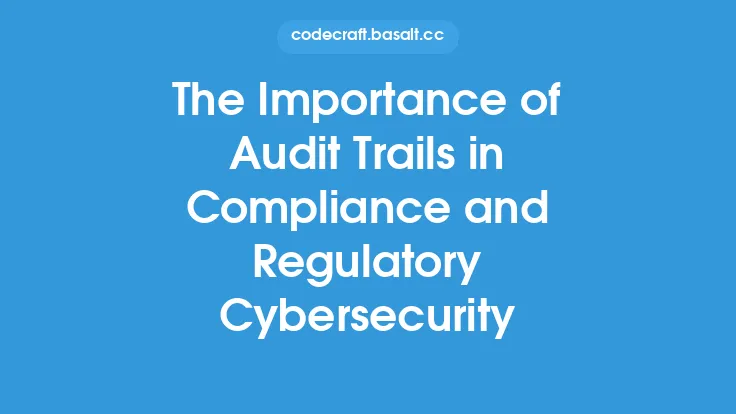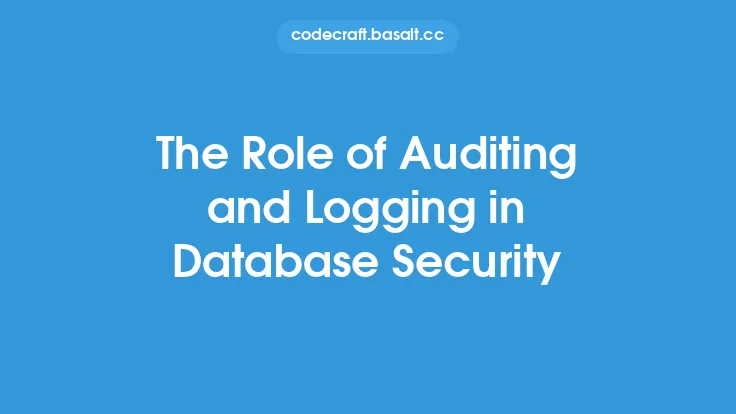In the realm of cybersecurity, compliance and regulatory requirements are becoming increasingly stringent, and documentation plays a vital role in ensuring that organizations meet these demands. As the threat landscape continues to evolve, it is essential for companies to maintain accurate, up-to-date, and comprehensive documentation to demonstrate their commitment to cybersecurity and compliance. This article will delve into the significance of documentation in compliance and regulatory cybersecurity, exploring its importance, benefits, and best practices.
Introduction to Compliance and Regulatory Cybersecurity
Compliance and regulatory cybersecurity refer to the processes and procedures that organizations must follow to ensure they adhere to relevant laws, regulations, and standards. This includes data protection, privacy, and security requirements, such as the General Data Protection Regulation (GDPR), the Health Insurance Portability and Accountability Act (HIPAA), and the Payment Card Industry Data Security Standard (PCI DSS). Compliance and regulatory cybersecurity involve implementing controls, policies, and procedures to mitigate risks, protect sensitive data, and prevent cyber threats.
The Importance of Documentation in Compliance and Regulatory Cybersecurity
Documentation is a critical component of compliance and regulatory cybersecurity. It provides a record of an organization's cybersecurity controls, policies, and procedures, demonstrating their commitment to compliance and regulatory requirements. Accurate and comprehensive documentation helps organizations to identify, assess, and mitigate risks, as well as to respond to audits and regulatory inquiries. Furthermore, documentation facilitates communication among stakeholders, including employees, customers, and regulators, ensuring that everyone is aware of the organization's cybersecurity posture and compliance status.
Types of Documentation in Compliance and Regulatory Cybersecurity
There are several types of documentation that are essential in compliance and regulatory cybersecurity, including:
- Policies and procedures: These documents outline an organization's cybersecurity controls, protocols, and guidelines, ensuring that employees understand their roles and responsibilities in maintaining cybersecurity and compliance.
- Risk assessments: These documents identify, assess, and prioritize potential risks to an organization's cybersecurity and compliance posture, helping to inform decision-making and resource allocation.
- Incident response plans: These documents outline the procedures to be followed in the event of a cybersecurity incident, ensuring that organizations can respond quickly and effectively to minimize damage and maintain compliance.
- Compliance reports: These documents provide evidence of an organization's compliance with relevant laws, regulations, and standards, demonstrating their commitment to cybersecurity and regulatory requirements.
- Audit trails: These documents provide a record of all changes, updates, and access to an organization's systems, data, and documentation, helping to detect and respond to potential security incidents.
Benefits of Documentation in Compliance and Regulatory Cybersecurity
The benefits of documentation in compliance and regulatory cybersecurity are numerous, including:
- Improved compliance: Documentation helps organizations to demonstrate their commitment to compliance and regulatory requirements, reducing the risk of non-compliance and associated penalties.
- Enhanced cybersecurity: Documentation facilitates the implementation of effective cybersecurity controls, policies, and procedures, helping to prevent cyber threats and protect sensitive data.
- Increased transparency: Documentation provides a clear understanding of an organization's cybersecurity posture and compliance status, facilitating communication among stakeholders and helping to build trust.
- Reduced risk: Documentation helps organizations to identify, assess, and mitigate risks, reducing the likelihood of cybersecurity incidents and associated consequences.
- Simplified audits: Documentation provides evidence of an organization's compliance and cybersecurity controls, simplifying the audit process and reducing the risk of non-compliance.
Best Practices for Documentation in Compliance and Regulatory Cybersecurity
To ensure that documentation is effective in compliance and regulatory cybersecurity, organizations should follow best practices, including:
- Develop a documentation strategy: Organizations should develop a comprehensive documentation strategy that outlines the types of documentation required, the frequency of updates, and the responsibilities of stakeholders.
- Use standardized templates: Organizations should use standardized templates to ensure consistency and accuracy in documentation, reducing the risk of errors and omissions.
- Maintain up-to-date documentation: Organizations should regularly review and update documentation to ensure that it remains accurate, comprehensive, and relevant.
- Provide training and awareness: Organizations should provide training and awareness programs to ensure that employees understand the importance of documentation in compliance and regulatory cybersecurity.
- Use version control: Organizations should use version control to track changes, updates, and access to documentation, helping to detect and respond to potential security incidents.
Technical Considerations for Documentation in Compliance and Regulatory Cybersecurity
From a technical perspective, documentation in compliance and regulatory cybersecurity should be implemented using secure and reliable methods, including:
- Encryption: Documentation should be encrypted to protect sensitive information and prevent unauthorized access.
- Access controls: Documentation should be subject to access controls, including authentication, authorization, and accounting (AAA) protocols, to ensure that only authorized personnel can access and modify documentation.
- Version control systems: Organizations should use version control systems, such as Git or Subversion, to track changes, updates, and access to documentation.
- Digital signatures: Documentation should be digitally signed to ensure authenticity and integrity, helping to prevent tampering and unauthorized modifications.
- Secure storage: Documentation should be stored in a secure and reliable repository, such as a document management system or a cloud-based storage service, to ensure that it is protected from unauthorized access, theft, or loss.
Conclusion
In conclusion, documentation plays a vital role in compliance and regulatory cybersecurity, providing a record of an organization's cybersecurity controls, policies, and procedures, and demonstrating their commitment to compliance and regulatory requirements. By following best practices and using secure and reliable methods, organizations can ensure that their documentation is effective in maintaining compliance and regulatory cybersecurity, reducing the risk of non-compliance and associated penalties, and protecting sensitive data from cyber threats.





